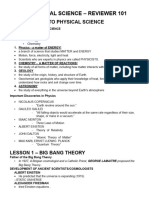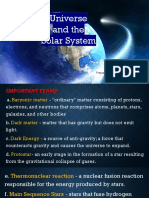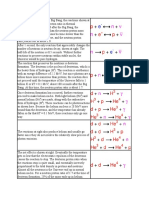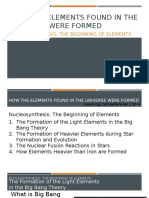0 ratings0% found this document useful (0 votes)
10 viewsFormation of Heavier Elements
Formation of Heavier Elements
Uploaded by
Gabrielle Ellis- The first elements, hydrogen and helium, formed during the Big Bang as the universe expanded and cooled. During stellar nucleosynthesis in stars, lighter elements fused to form heavier ones through processes like the proton-proton chain reaction.
- Elements heavier than iron formed through rapid neutron capture in supernovae or the slow neutron capture process in AGB stars. The heaviest elements are synthesized artificially in laboratories through bombardment of target nuclei.
Copyright:
© All Rights Reserved
Available Formats
Download as PPTX, PDF, TXT or read online from Scribd
Formation of Heavier Elements
Formation of Heavier Elements
Uploaded by
Gabrielle Ellis0 ratings0% found this document useful (0 votes)
10 views40 pages- The first elements, hydrogen and helium, formed during the Big Bang as the universe expanded and cooled. During stellar nucleosynthesis in stars, lighter elements fused to form heavier ones through processes like the proton-proton chain reaction.
- Elements heavier than iron formed through rapid neutron capture in supernovae or the slow neutron capture process in AGB stars. The heaviest elements are synthesized artificially in laboratories through bombardment of target nuclei.
Original Description:
Grade 11 Physical Science
Copyright
© © All Rights Reserved
Available Formats
PPTX, PDF, TXT or read online from Scribd
Share this document
Did you find this document useful?
Is this content inappropriate?
- The first elements, hydrogen and helium, formed during the Big Bang as the universe expanded and cooled. During stellar nucleosynthesis in stars, lighter elements fused to form heavier ones through processes like the proton-proton chain reaction.
- Elements heavier than iron formed through rapid neutron capture in supernovae or the slow neutron capture process in AGB stars. The heaviest elements are synthesized artificially in laboratories through bombardment of target nuclei.
Copyright:
© All Rights Reserved
Available Formats
Download as PPTX, PDF, TXT or read online from Scribd
Download as pptx, pdf, or txt
0 ratings0% found this document useful (0 votes)
10 views40 pagesFormation of Heavier Elements
Formation of Heavier Elements
Uploaded by
Gabrielle Ellis- The first elements, hydrogen and helium, formed during the Big Bang as the universe expanded and cooled. During stellar nucleosynthesis in stars, lighter elements fused to form heavier ones through processes like the proton-proton chain reaction.
- Elements heavier than iron formed through rapid neutron capture in supernovae or the slow neutron capture process in AGB stars. The heaviest elements are synthesized artificially in laboratories through bombardment of target nuclei.
Copyright:
© All Rights Reserved
Available Formats
Download as PPTX, PDF, TXT or read online from Scribd
Download as pptx, pdf, or txt
You are on page 1of 40
Formation of
Heavier Elements
Physical Science
Prepared By: Francess Johanna F. Dela Fuente
BIG BANG MODELS
• Is the cosmological models based on general relativity –
tell us that the early universe was extremely hot and dense.
• At the earliest stages that can be modeled using current
physical theories, the universe was filled with radiation
and elementary particles – a hot plasma in which energy
was distributed evenly.
Big Bang Nucleosynthesis
• As the universe cools, the matter content changes – new
particles are formed out of the preexisting ones, such as
protons and neutrons forming out of quarks.
• From about one second to a few minutes cosmic time, when
the temperature has fallen below 10 billion Kelvin, the
conditions are just right for protons and neutrons to combine
and form certain species of atomic nuclei.
Life Cycle of a Star
• Nucleosynthesis is the process by which atoms of lighter chemical
elements fuse together, creating atoms of heavier elements.
• Atoms are comprised of three elementary particles - protons and
neutrons bound into a dense nucleus and electrons surrounding that
nucleus.
• In the fusion process, light nuclei collide, recombine their protons and
neutrons into heavier nuclei, and release energy. This process requires
tremendous amounts of heat and energy; as such this fusion can only
happen in extreme environments.
QUESTION
WHAT IS THE NEAREST
STAR TO PLANET EARTH?
Life Cycle of a Star
• Stars populate the universe with elements
through their “lifecycle”—an ongoing process of
formation, burning fuel, and dispersal of
material when all the fuel is used up.
Life Cycle of a Star
• All stars form in nebulae, which are huge clouds of
gas and dust.
• Though they shine for many thousands, and even
millions of years, stars do not last forever.
• The changes that occur in a star over time and the
final stage of its life depend on a star's size.
Life Cycle of a Star
• Main sequence: Nuclear reactions at the centre (or core) of
a star provides energy which makes it shine brightly.
• The exact lifetime of a star depends very much on its size.
Very massive stars use up their fuel quickly. This means
they may only last a few hundred thousand years. Smaller
stars use up fuel more slowly so will shine for several
billion years.
Life Cycle of a Star
• Eventually, the hydrogen which powers the
nuclear reactions inside a star begins to run out.
The star then enters the final phases of its
lifetime. All stars will expand, cool and change
color to become a red giant.
Life Cycle of a Star
• A massive star experiences a much more energetic and violent end.
It explodes as a supernova. This scatters materials from inside the
star across space to recombine as future stars, planets, and asteroids,
or even eventually life like us
• This material can collect in nebulae and form the next generation of
stars. After the dust clears, a very dense neutron star is left behind.
These spin rapidly and can give off streams of radiation, known as
pulsars.
Life Cycle of a Star
• If the remnant is more than three times as massive as
the Sun, gravity overwhelms the neutrons and the star
collapses completely into a black hole—so-called
because the matter within is so compressed and the pull
of gravity is so intense that even light is drawn in and
not reflected, so that area is “black” or unobservable.
QUESTION
WHAT IS MORE LIKELY
TO HAPPEN TO OUR SUN
AT ITS FINAL PHASE?
Formation of Heavier Elements
• A supernova generates such an unbelievable burst of energy. In
this brief moment, dozens of elements heavier than iron can also
be synthesized such as Nickel, Copper, Zinc, Silver, and Gold.
• Any element with an atomic number greater than twenty-six
is made either in a supernova or a rare event like a collision of a
two-neutron star or a neutron star with a black hole.
Proton-proton chain reaction
• A proton–proton chain reaction is one of the ways
by which stars fuse hydrogen into helium. It is the
reaction that dominates in stars the size of the Sun
or average-sized stars, where they get their energy
and convert Hydrogen into Helium
Proton-proton chain reaction
• Stars with a mass of about 1.5 solar masses or
more produce most of their energy by a different
form of hydrogen fusion, the CNO cycle.
• CNO stands for Carbon, Nitrogen, and
Oxygen as nuclei of these elements are involved
in the process.
TRIPLE ALPHA PROCESS
• The triple alpha process is a nuclear fusion process where three helium
nuclei are combined to form a carbon-12 nucleus (C-12). The C-12
nucleus can sometimes capture an additional He-4 nucleus to produce an
oxygen-16 nucleus (O-16).
Proton-proton chain and CNO cycle
• Proton-proton chain and CNO cycle cause He-4
nuclei to accumulate in the core of main-sequence
stars.
• When a main-sequence star evolves into its next
stage (e.g., red giant), the core temperature of the
star becomes sufficient for the triple-alpha process
to take place.
ALPHA LADDER PROCESS
• Stars accumulate more mass and continue to
grow into red super giants.
• Alpha particle fusion happens at its core and
creates heavier elements until Iron (Fe). This is
called the Alpha ladder process.
How do elements heavier than Iron form?
• In the growing ball of gas, strontium was found to absorb
light at wavelengths between 350 and 850 nanometers,
according to computer simulations. They noticed dips in
the spectra at those wavelengths when they reexamined
the X-shooter spectra. The end outcome was Strontium
with a mass of five Earth masses.
SLOW PROCESS/S-PROCESS
• In the creation of heavier elements, neutron capture
can occur slowly or quickly.
• When radioactive decay occurs more quickly than
neutron capture, the S-process, also known as the
slow process, happens, which raises the proton by
one.
SLOW PROCESS/S-PROCESS
RAPID NEUTRON CAPTURE/R-
PROCESS
• It refers to a higher rate of neutron capture before
radioactive decay, which leads to more neutrons
combining at the nucleus.
• Elements heavier than Iron originate during
supernova nucleosynthesis, which takes place in
this process.
RAPID NEUTRON CAPTURE/R-
PROCESS
SUMMARY
• Neutrons, protons, and electrons are the three
minuscule components that make up an element.
• The first elements to exist are Hydrogen and
Helium. It was an elementary particle at the
beginning of the Big Bang.
• During the period of the proton-proton chain
reaction, during which protons fused into helium,
the universe expanded and cooled.
SUMMARY
• The Universe expands right through this
potential, and the density and temperature
quickly fall too low to support the synthesis of
any more elements. Red giant cores get beyond
this through the Triple-Alpha process.
Synthesis of New
Elements
Dmitri
Mendeleev
• A Russian chemist,
who devised the
Periodic Table of
Elements — a
comprehensive
system for classifying
chemical elements.
Henry Moseley
• An English physicist, (1913) who used X-
rays to measure the wavelengths of elements
and correlated these measurements to their
atomic numbers.
• He then rearranged the elements in the
periodic table on the basis of atomic
numbers. This helped explain disparities in
earlier versions that had used atomic masses.
Discovery of Nuclear Transmutation
• In 1919, Ernest Rutherford successfully carried out a nuclear
transmutation reaction — a reaction involving the transformation of one
element or isotope into another element.
• The first nuclide to be prepared by artificial means was an isotope of
oxygen, 17O. It was made by Ernest Rutherford in 1919 by bombarding
Nitrogen atoms with alpha particles.
Ernest Rutherford
• James Chadwick discovered the neutron in 1932, as a previously
unknown neutral particle produced along with Carbon-12 by the
nuclear reaction between Beryllium-9 and Helium-4.
• The first element to be prepared that does not occur naturally on
the earth, Technetium, was created by bombardment of
Molybdenum by deuterons (heavy Hydrogen, H12), by Emilio
Segre and Carlo Perrier in 1937
The Discovery of the Missing Elements
• In 1937, American physicist Ernest Lawrence
synthesized element with atomic number 43 using a
linear particle accelerator. He bombarded
molybdenum (Z=42) with fast-moving neutrons. The
newly synthesized element was named Technetium
(Tc) after the Greek word "technêtos" meaning
“artificial.” Tc was the first man-made element.
The Discovery of the Missing Elements
• In 1940, Dale Corson, K. Mackenzie, and Emilio Segre
discovered element with atomic number 85. They bombarded
atoms of Bismuth (Z=83) with fastmoving alpha particles in a
cyclotron. A cyclotron is a particle accelerator that uses
alternating electric field to accelerate particles that move in a
spiral path in the presence of a magnetic field. Element-85 was
named Astatine from the Greek word “astatos” meaning unstable.
The Transuranic Elements
• Transuranic elements are chemical elements with
atomic numbers greater than 92, which means they
have more protons in their nuclei than uranium (atomic
number 92). These elements are all synthetic and do
not occur naturally in significant quantities on Earth.
•
The Superheavy Elements
Superheavy elements are those with atomic numbers
significantly higher than those found in the periodic table of
naturally occurring elements. They are highly unstable and
are typically synthesized in laboratories through nuclear
reactions. Here is a list of some superheavy elements along
with their atomic numbers:
The Superheavy Elements
Nihonium (Nh) - Atomic Number 113
Flerovium (Fl) - Atomic Number 114
Moscovium (Mc) - Atomic Number 115
Livermorium (Lv) - Atomic Number 116
Tennessine (Ts) - Atomic Number 117
Oganesson (Og) - Atomic Number 118
PERFORMANCE TASK
• Create an output that discusses the origin of one of the man-
made elements. In your output, you must:
• discuss the element’s basic characteristics
• give a brief timeline leading up to the element’s discovery
• You may present your research in the form of a poster,
PowerPoint, a report or essay, video, or infographic.
You might also like
- TG SHS Earth ScienceDocument107 pagesTG SHS Earth ScienceErsan Resurreccion100% (2)
- Stellar NucleosynthesisDocument23 pagesStellar NucleosynthesisAnanyo BhattacharyyaNo ratings yet
- Pointers To ReviewDocument8 pagesPointers To Reviewhood64318No ratings yet
- Nucleosynthesis and Nuclear Reactions 2Document48 pagesNucleosynthesis and Nuclear Reactions 210C- Navarro, Cattlyn, ShaneNo ratings yet
- Lesson 2 - The Formation of Heavier Elements in The UniverseDocument43 pagesLesson 2 - The Formation of Heavier Elements in The Universetheresa balatico100% (1)
- Reviewer Physical ScienceDocument17 pagesReviewer Physical ScienceMarian AnormaNo ratings yet
- Reviewer Physical Science 3RD QuarterDocument4 pagesReviewer Physical Science 3RD Quarterwiljayraphaelviolanda11h11aNo ratings yet
- Nucleosynthesis-Stellar EvolutionDocument38 pagesNucleosynthesis-Stellar EvolutionYashashavi Ladha100% (2)
- 1 - Formation of Heavier ElementsDocument74 pages1 - Formation of Heavier Elementsitsmetins25No ratings yet
- Origin of The Universe PPT Earth and Life ScienceDocument33 pagesOrigin of The Universe PPT Earth and Life ScienceCarlos TuazonNo ratings yet
- Physical ScienceDocument16 pagesPhysical ScienceAlthea Lyn MirandaNo ratings yet
- Origin of ElementsDocument27 pagesOrigin of ElementsJoanna Ruth SeproNo ratings yet
- Concept of Atomic Number Led To The SynthesisDocument52 pagesConcept of Atomic Number Led To The SynthesisGian Carlo Limpin100% (2)
- Q1 Lesson 1Document47 pagesQ1 Lesson 1Mark Jade HenegabuasNo ratings yet
- Physical Science SHS 1.2 Stellar Evolution and The Formation of Heavier Elements PDFDocument26 pagesPhysical Science SHS 1.2 Stellar Evolution and The Formation of Heavier Elements PDFEzekiel Lapitan100% (1)
- Physical Science Summary Lesson 1Document4 pagesPhysical Science Summary Lesson 1mariejoydelacruz877No ratings yet
- Module 3Document8 pagesModule 3SeviNo ratings yet
- 1 - Physical Science The Origin of The ElementsDocument25 pages1 - Physical Science The Origin of The ElementsTom FernandoNo ratings yet
- Physical Science SHS 1.2 Stellar Evolution and The Formation of Heavier ElementsDocument26 pagesPhysical Science SHS 1.2 Stellar Evolution and The Formation of Heavier ElementsGarex Allan RotsapNo ratings yet
- Lesson 1 - Formation of The Elements in The Universe Physical ScienceDocument35 pagesLesson 1 - Formation of The Elements in The Universe Physical Sciencepreciousbesa14No ratings yet
- NucleosynthesisDocument49 pagesNucleosynthesisJeanine CristobalNo ratings yet
- The Formation of ElementsDocument30 pagesThe Formation of Elementsadityaraj8559No ratings yet
- Phisay-Reviewer. 2Document14 pagesPhisay-Reviewer. 2bkrystyngryzNo ratings yet
- Science Week 1 - Origin of The Elements: 2 SemesterDocument8 pagesScience Week 1 - Origin of The Elements: 2 SemesterBOBBY AND KATESNo ratings yet
- UntitledDocument30 pagesUntitledKrizalyn Salvador LopezNo ratings yet
- Physical ScienceDocument4 pagesPhysical SciencestudentNo ratings yet
- PS Chapter 1Document46 pagesPS Chapter 1Jonamae LauronNo ratings yet
- Quipper Lecture Physical ScienceDocument326 pagesQuipper Lecture Physical ScienceLoren Marie Lemana AceboNo ratings yet
- Lecture OverviewDocument34 pagesLecture OverviewnayemNo ratings yet
- Quipper Lecture Physical ScienceDocument279 pagesQuipper Lecture Physical ScienceLoren Marie Lemana AceboNo ratings yet
- Physical Sciences Lesson 1 NucleosynthesisDocument14 pagesPhysical Sciences Lesson 1 NucleosynthesisJustin BirdNo ratings yet
- Key PointsDocument20 pagesKey PointsRoldan CawaloNo ratings yet
- Formation of The Elements and Nuclear ReactionsDocument23 pagesFormation of The Elements and Nuclear ReactionsNYL BRIAN BUISERNo ratings yet
- Stellar NucleusynthesisDocument30 pagesStellar NucleusynthesisreneicrizaldoNo ratings yet
- Ssci2 - Physical Science Lesson 1: Formation of Light and Heavy Elements in The UniverseDocument20 pagesSsci2 - Physical Science Lesson 1: Formation of Light and Heavy Elements in The UniverseMs. ArceñoNo ratings yet
- 1 Formation of The Elements During The Big BangDocument56 pages1 Formation of The Elements During The Big BangMary Ann GubanNo ratings yet
- Physical Science Quarter 1Document74 pagesPhysical Science Quarter 1Arr FernandezNo ratings yet
- Introduction To Astrophysics: Lecture 7: Stellar Life and DeathDocument28 pagesIntroduction To Astrophysics: Lecture 7: Stellar Life and DeathNaila KhanNo ratings yet
- P6 Lesson 1 - Elements Atoms and Their HistoryDocument88 pagesP6 Lesson 1 - Elements Atoms and Their HistorychristinejgualbertoNo ratings yet
- Nuclear Reactions and Origin of ElementsDocument58 pagesNuclear Reactions and Origin of ElementsReycel Jane Ycoy100% (3)
- Daniel, Reyden R. Abm 11 Sy Reviewer in Physical ScienceDocument23 pagesDaniel, Reyden R. Abm 11 Sy Reviewer in Physical ScienceREYNIEL ANGELIE DANIELNo ratings yet
- Formation of ElementsDocument4 pagesFormation of ElementsPatotie CorpinNo ratings yet
- Lecturer 1Document38 pagesLecturer 1nayemNo ratings yet
- 2 Science 1st Monthly Exam ReviewerDocument3 pages2 Science 1st Monthly Exam Reviewerl.sioco.tc.119391No ratings yet
- Earth and Life ScienceDocument48 pagesEarth and Life ScienceAngelica SeñaNo ratings yet
- Exploring The Formation of Elements During Stellar FormationDocument14 pagesExploring The Formation of Elements During Stellar FormationsidicinshiraNo ratings yet
- Reviewer in Physical ScienceDocument10 pagesReviewer in Physical ScienceChristy GonzalesNo ratings yet
- 4nucleosynthesis The Beginning of ElementsDocument10 pages4nucleosynthesis The Beginning of ElementsRolando VergoniaNo ratings yet
- ADM Module-1-4-Physical-ScienceDocument30 pagesADM Module-1-4-Physical-ScienceDaniel TaleñoNo ratings yet
- Physical Science (Quarter 3 Week 1-2) : Compiled By: Richard Gamaliel C. Cortez, RN, LPTDocument4 pagesPhysical Science (Quarter 3 Week 1-2) : Compiled By: Richard Gamaliel C. Cortez, RN, LPTRogeilyn CalimpongNo ratings yet
- Origin of Universe AutosavedDocument47 pagesOrigin of Universe AutosavedCathleen Jasmine MarfilNo ratings yet
- The Bigbang TheoryDocument30 pagesThe Bigbang TheoryKhyza Cathrene Caliso OringotNo ratings yet
- Week 2 Solar System EarthDocument83 pagesWeek 2 Solar System EarthmuhammadNo ratings yet
- Earth Life Science Module 1Document18 pagesEarth Life Science Module 1Rosalyn Pagatpatan BarolaNo ratings yet
- Earth Science ReviewerDocument19 pagesEarth Science ReviewerShaina Rhaine DigaNo ratings yet
- Big Bang: Where Did All The Elements Come From??Document10 pagesBig Bang: Where Did All The Elements Come From??Stardoll DefNo ratings yet
- Origin of The Universe: Understanding Earth's UniquenessDocument59 pagesOrigin of The Universe: Understanding Earth's UniquenessGopalBanik100% (1)
- A Piece of the Sun: The Quest for Fusion EnergyFrom EverandA Piece of the Sun: The Quest for Fusion EnergyRating: 3 out of 5 stars3/5 (4)
- The Big Backyard: The Solar System beyond PlutoFrom EverandThe Big Backyard: The Solar System beyond PlutoRating: 5 out of 5 stars5/5 (1)
- A Beginner's and Expert's Guide To The Big BangDocument19 pagesA Beginner's and Expert's Guide To The Big BangJason LambNo ratings yet
- Astr101 - MCQ BankDocument16 pagesAstr101 - MCQ BankahmadnooraldeenNo ratings yet
- NUCLEOSYNTHESISDocument20 pagesNUCLEOSYNTHESISchuryeon100% (1)
- Formation of Chemical ElementsDocument4 pagesFormation of Chemical Elementsgeron pierre BayatanNo ratings yet
- Module in Physical ScienceDocument42 pagesModule in Physical ScienceNeil Duyag100% (1)
- Timeline of The Big Bang - WikipediaDocument12 pagesTimeline of The Big Bang - WikipediamexcesNo ratings yet
- Big Bang Nucleosynthesis ExplanationDocument7 pagesBig Bang Nucleosynthesis ExplanationMORAN DianaNo ratings yet
- Scientiæ Baccalaureus: A Physics Research TextDocument258 pagesScientiæ Baccalaureus: A Physics Research TextPerry Lee GordonNo ratings yet
- 2.origin of Light ElementsDocument21 pages2.origin of Light ElementsMaricon Villalobos Ruperez100% (1)
- Midterm Exam PhySci SY 2018-2019Document6 pagesMidterm Exam PhySci SY 2018-2019Jhen BarnardNo ratings yet
- Physical ScienceDocument14 pagesPhysical Sciencehello hahahNo ratings yet
- NucleosynthesisDocument4 pagesNucleosynthesisBerenice PantiiNo ratings yet
- Phosphorus Past and Future Jim Elser Full Chapter PDFDocument69 pagesPhosphorus Past and Future Jim Elser Full Chapter PDFdeepupazini100% (13)
- Scott Dodelson - Fabian Schmidt - Modern Cosmology (2021)Document497 pagesScott Dodelson - Fabian Schmidt - Modern Cosmology (2021)Rade RaonicNo ratings yet
- Physical Science LPDocument16 pagesPhysical Science LPHenno Nickole Vince A. BugtongNo ratings yet
- Chapter 1Document2 pagesChapter 1michelleNo ratings yet
- Grade 11 Physical Science Module 1: First Quarter (Week 1) Nucleosynthesis: The Formation of ElementsDocument22 pagesGrade 11 Physical Science Module 1: First Quarter (Week 1) Nucleosynthesis: The Formation of ElementsThea RufinoNo ratings yet
- New DLL Physical ScienceDocument55 pagesNew DLL Physical ScienceGirl from the NorthNo ratings yet
- Lesson 1 in The Beginning (Big Bang Theory and Formation of The Light Elements)Document4 pagesLesson 1 in The Beginning (Big Bang Theory and Formation of The Light Elements)Cristina MaquintoNo ratings yet
- Ssci2 - Physical Science Lesson 1: Formation of Light and Heavy Elements in The UniverseDocument20 pagesSsci2 - Physical Science Lesson 1: Formation of Light and Heavy Elements in The UniverseMs. ArceñoNo ratings yet
- 1 Learning Module Physical ScienceDocument13 pages1 Learning Module Physical ScienceFayeNo ratings yet
- The Primordial Lithium ProblemDocument29 pagesThe Primordial Lithium ProblemVINICIUS RODRIGUES GOMES DE FREITASNo ratings yet
- UENG 103 Introduction To Earth and Its Environment Feb 28 - 2023Document96 pagesUENG 103 Introduction To Earth and Its Environment Feb 28 - 2023swayangsiddha goswamiNo ratings yet
- Structure, Composition and Age: Three Most Abundant ElementsDocument2 pagesStructure, Composition and Age: Three Most Abundant ElementsErullyn KimNo ratings yet
- The Origin of ElementsDocument36 pagesThe Origin of ElementsKatherine AliceNo ratings yet
- (Notes) The UniverseDocument3 pages(Notes) The UniverseDenver Cho-oyNo ratings yet
- I.Objectives: Ii - Content Iii - Learning ResourcesDocument15 pagesI.Objectives: Ii - Content Iii - Learning ResourcesRussiel DagohoyNo ratings yet
- Origin of The Universe Non-Scientific ThoughtDocument1 pageOrigin of The Universe Non-Scientific ThoughtHibari ShinjiNo ratings yet
- The Universe and The Solar SystemDocument69 pagesThe Universe and The Solar SystemJustin Mhel VaquilarNo ratings yet
























































































